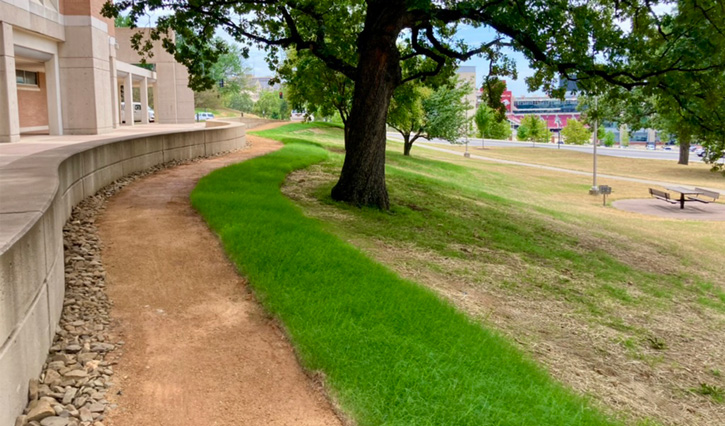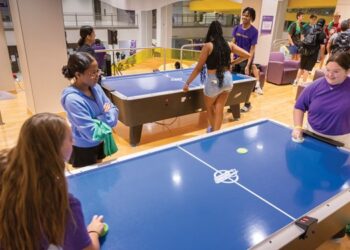Northwest Arkansas is home to an extensive 300-mile network of bicycle-friendly, natural surface trails. But in nearby Fayetteville, there were formerly no connections between the network of routes and the University of Arkansas (U of A).
That changed in summer of 2020 when U of A partnered with the City of Fayetteville, the Trailblazers, the Walton Family Foundation and the Walton Personal Philanthropy Group to begin construction on the Fayetteville Traverse Trail.
The 18-mile natural-surface loop is nearing full completion and will connect the school with other bike paths in the area.
Joining the trail later this month will be the Tsa La Gi Bike Park — a skill-building area featuring different paths to help riders progress their mountain-biking skills. Both will be open to students around the start of the fall semester.
“These types of campus amenities are what students are looking for. They also provide University Recreation (UREC) outstanding programming on our campus,” said Eric Boles, the director of the Office for Sustainability. “Additionally, providing these trails on campus not only improves our landscape but provides student recreational opportunities without leaving the neighborhood.”
Fayetteville Traverse Trail
Boles said the traverse trail is part of the university’s vision to create one of the most bicycle-friendly campuses in the country considering the U of A campus community now has 35,000 daily visitors.
“There is a growing interest in walkable and bikeable infrastructure,” he said. “Travel trends are steadily changing. Active transportation modes are increasing, up 11% since 2015, with less than 40% of affiliates purchasing parking permits. Our students are looking for more ways to get around. Trails are a great option.”

The new addition to campus will begin at the Sam M. Walton College of Business. From there, the trail meanders through a mix of hardwood forests, resident halls, educational buildings and creeks on its way around campus.
Boles said the Fayetteville Traverse Trail will hopefully provide Uof A the following benefits:
- A healthier, happier and productive student body and workforce.
- Less work/study time lost to traffic congestion.
- Reduced parking demand and associated costs.
- Improved institutional brand.
- Research opportunities with regional bicycle companies.
“The Trailblazers — a non-profit organization that develops multi-use trails — has been integral to ensuring the outcomes of this collaborative effort are world-class in terms of the design, construction and the user’s experience,” he added.
Tsa La Gi Bike Park
While U of A Facilities Management Planning and Design Office and the Office for Sustainability are overseeing the Fayetteville Traverse Trail project, UREC oversees the regular management and programming of the bike park. The grand opening is scheduled for August 25, 2022.
“Different paths through the park have challenges participants must overcome based on their skill level,” said Caitlin Arnett, the coordinator for UREC Outdoors. “This way, bikers don’t have to fully commit to high-consequence features. Instead, they can build up to difficult obstacles over time by gaining confidence.”
EXTRA CREDIT: It’s important to keep experience levels in mind when planning activities and trips.
“With the region becoming a destination riding location, it becomes a strong recruitment tool for students who enjoy cycling and staying active,” said Arnett. “I think this benefits UREC Outdoors because the amount of engagement and community building within the program increases as more students become involved. UREC has a mission to empower students through recreation and wellness. UREC Outdoors provides a space for cyclists to connect and be active together.”
She added that outdoor exercise offers mental health benefits as well due to the environment reducing stress and increasing social bonding.
“When the COVID-19 pandemic began, I think it was seen as a necessity to go outside to be physically active,” said Arnett. “But I think a lot of people ended up enjoying being outside and were able to really engage in the spaces like they hadn’t before, so the trend is sticking.
“We see these amenities as a great way to build relationships and enhance individual health,” added Boles. “These projects also aid in the reduction of our carbon footprint and work toward the university’s goal of carbon neutrality.”










